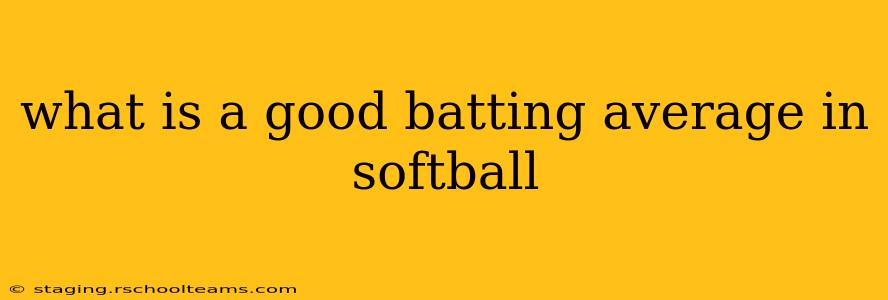A "good" batting average in softball is relative and depends on several factors, including the level of play (youth, high school, college, professional), the specific league, and the overall strength of the competition. However, we can establish some general guidelines to understand what constitutes a respectable and excellent batting average.
Generally speaking, a batting average above .300 is considered very good in most softball leagues. A .400 average is exceptional and often indicates a truly outstanding hitter. Let's delve deeper into the specifics.
What is considered a good batting average in different softball levels?
Youth Softball: In youth leagues, where the focus is often on development and fun, the competition varies widely. A batting average around .300-.350 can be considered very good for a young player, while anything above .400 is outstanding. Consistency and improvement over time are often more important metrics to track than just the raw batting average.
High School Softball: The competition intensifies at the high school level. A batting average of .350 or higher is generally considered excellent, reflecting a significant contribution to the team's offensive success. A .400+ average often puts a player in contention for all-league or all-state honors.
College Softball: College softball boasts some of the most talented players in the country. The competition is fierce, and a batting average above .300 is typically a hallmark of a strong hitter, indicating a player who regularly gets on base and contributes to the team's scoring potential. Averages of .350 or higher are often seen in All-American players.
Professional Softball: Professional softball features elite athletes, and competition is extremely high. Batting averages in the .300s are excellent and quite rare. Anything above .350 would be considered phenomenal and among the best in the league.
What factors influence a good batting average besides skill?
While individual skill is a major component, several other factors affect batting averages:
- League Strength: Playing in a league with consistently strong pitching will naturally lower the overall batting averages.
- Playing Position: Some positions might have players who are intentionally walked more frequently, artificially lowering their batting average.
- Luck: Even the best hitters will sometimes hit into bad luck with well-placed defensive plays, even with well-hit balls.
- Pitch Type and Speed: The type of pitches faced and their speed also greatly influence success at the plate.
How can I improve my softball batting average?
Improving your softball batting average requires consistent practice and dedication. This involves:
- Consistent Practice: Regular batting practice is crucial for developing muscle memory, refining technique, and improving timing.
- Fundamental Skills: Mastering the fundamentals of hitting, including stance, grip, swing mechanics, and follow-through, forms the foundation for a strong batting average.
- Game Strategy: Understanding pitch selection and game situations helps hitters make smarter decisions at the plate.
- Mental Game: Maintaining focus, confidence, and a positive attitude are vital for successful hitting.
Is on-base percentage a better indicator of offensive performance?
While batting average is a commonly used metric, on-base percentage (OBP) often provides a more comprehensive view of a hitter's offensive contribution. OBP includes walks, hit-by-pitches, and other ways a batter gets on base, providing a more accurate picture of how often a player reaches base, regardless of whether it's a hit. A high OBP indicates a player who consistently gets on base and creates scoring opportunities for the team, even without a high batting average.
In conclusion, while a batting average above .300 is generally considered good, the context is crucial. Consider the level of play, the strength of the league, and other factors when evaluating a softball player's hitting performance. A high on-base percentage often complements and enhances the importance of a good batting average, giving a more complete picture of offensive skill.
